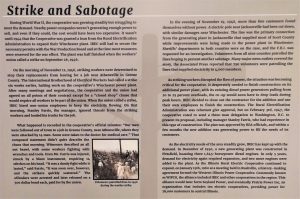Text:
Strike and Sabotage
During World War II, the cooperative was growing steadily but struggling to meet the demand. Nearby power companies weren’t generating enough power to sell, and even if they could, the cost would have been too expensive. It wasn’t until 1944 that the Cooperative was granted a loan from the Rural Electrification Administration to expand their Winchester plant. IREC still had to secure the necessary permits with the War Production Board and at the time most resources were reserved for the war effort. The plant was half finished when the workers’ union called a strike on September 26, 1946.
On the morning of November 12, 1946, striking workers were determined to stop their replacements from leaving for a job near Athensville in Greene County. The International Brotherhood of Electrical Workers had called a strike six weeks earlier, halting work on the cooperative’s Winchester power plant. After many meetings and negotiations, the cooperative and the union had agreed on all points of their contract except for a “closed shop” clause that would require all workers to be part of the union. When the union called a strike, IREC hired non-union employees to keep the electricity flowing. On that morning, Stanley Farris, the manager, ignored threats from the striking workers and loaded his trucks for the job.
What happened is recorded in the cooperative’s official minutes: “Our men were followed out of town to a job in Greene County, near Athensville, where they were attacked by 14 men. Some were taken to the doctor for medical care.” That composed statement didn’t quite describe the chaos that morning. Witnesses described an all out brawl, with some workers fighting with wrenches and tools. Even Mr. Farris was injured, struck by a blunt instrument, requiring 14 stitches on his head. “It was a dandy fight while it lasted,” said Farris, “It was soon over, however, and the strikers quickly scattered.” The offenders were arrested and later released on a 500 dollar bond each, paid for by the union.
In the evening of November 19, 1946, more than 800 customers found themselves without power. A electric pole near Jacksonville had been cut down, with similar damages near Winchester. The line was the primary connection from the generating plant in Jacksonville that supplied most of Scott County while improvements were being made to the power plant in Winchester. Sheriffs’ departments in both counties were on the case, and the F.B.I. was requested for an investigation. Volunteers from all nine counties patrolled the lines hoping to prevent another sabotage. Many major news outlets covered the story, the Associated Press reported that 750 volunteers were patrolling the lines that supplied electricity to 4,000 members.
As striking workers disrupted the flow of power, the situation was becoming critical for the cooperative. It desperately needed to finish construction on its additional power plant, with its existing diesel power generators pulling from 20 to 25 percent overloads, the co-op would soon have to drop loads during peak hours. IREC decided to close out the contractor for the addition and use their own employees to finish the construction. The Rural Electrification Administration was reluctant give approval, but on February 3rd, 1947, the cooperative voted to send a three-man delegation to Washington, D.C. to present its proposal, including manager Stanley Farris, who had experience in this type of construction. The plan was approved by REA officials, and within a few months the new addition was generating power to fill the needs of its customers.
As the electricity needs of the area steadily grew, IREC has kept up with the demand. In December of 1950, a new generating plant was constructed in Pittsfield, boasting three 1,645-horsepower diesel engines. In only 5 years, demand for electricity again required expansion, and two more engines were added to the plant. As the Illinois Rural Electric Cooperative continued to expand, on January 15th, 1960 at a meeting held in Rushville, a history-making agreement formed the Western Illinois Power Cooperative. Commonly known as WIPCO, the alliance included IREC and other cooperatives in the region. This alliance would later form Soyland Power, and eventually Prairie Power Inc, an organization that includes ten electric cooperatives, providing power for 78,000 customers in central Illinois.




